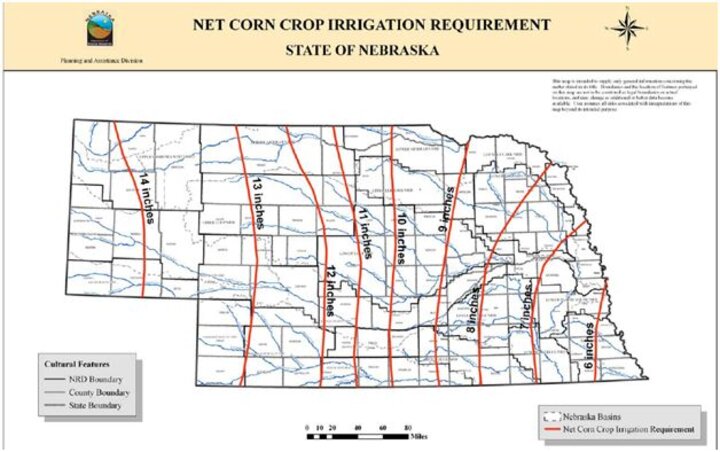Precipitation Patterns
Another major factor in irrigation scheduling is making use of precipitation, both during the growing season and in the off season. Shown below is a map detailing the average net irrigation requirement for corn for the State of Nebraska.
The net irrigation requirement is based on precipitation patterns and soils. In wet years less water is needed and in dry years more water will be needed.
- View the map below to see the net irrigation requirement for your area.

- Divide net irrigation requirement by the application efficiency of your irrigation system (Table 1). The result is the average gross amount of irrigation you need to apply in an average year.
- If you normally pump more than the average gross amount, you might consider a different method of scheduling your irrigations.
| System | Overall Efficiency, % | |
|---|---|---|
| Furrow Irrigation | Every Row | 40-75 |
| With Surge Valve | 60-85 | |
| With Reuse | 55-90 | |
| Siphon Tube | 40-75 | |
| Alternate Row | 60-85 | |
| Sprinkler Irrigation | Hand Move | 60-80 |
| Solid Set | 60-85 | |
| Traveler | 55-75 | |
| High Pressure Impact | 70-80 | |
| Low Pressure Impact | 75-85 | |
| Low Pressure Spray | 70-90 | |
| Low Pressure Bubble | 60-95 | |
| Drip Irrigation | 70-95 |
Gross irrigation calculator (below) can help you determine the average gross amount of irrigation that you will need to apply in order to meet water demand of corn.
Download Calculator (.xls)
A way to significantly reduce irrigation requirements is to leave more crop residue on the field and practice less tillage. For more information:
- Reduce Need for Irrigation by Maintaining Crop Residue and Reducing Soil Tillage
- Calculator: Dollar savings from irrigating less (.xls)
In some areas where water restrictions are significant, deficit irrigation of crops may need to be practiced.
Under allocation most producers will not be able to pump the economical optimal amount of irrigation water. In addition to good irrigation management, producers may need to consider other water saving practices.